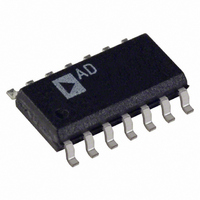AD8277ARZ Analog Devices Inc, AD8277ARZ Datasheet - Page 18

AD8277ARZ
Manufacturer Part Number
AD8277ARZ
Description
IC AMP GP UNITY GAIN DIFF 14SOIC
Manufacturer
Analog Devices Inc
Datasheet
1.AD8277ARZ.pdf
(20 pages)
Specifications of AD8277ARZ
Amplifier Type
Differential
Number Of Circuits
2
Output Type
Rail-to-Rail
Slew Rate
1.1 V/µs
Gain Bandwidth Product
550kHz
Voltage - Input Offset
100µV
Current - Supply
200µA
Current - Output / Channel
15mA
Voltage - Supply, Single/dual (±)
2 V ~ 36 V, ±2 V ~ 18 V
Operating Temperature
-40°C ~ 85°C
Mounting Type
Surface Mount
Package / Case
14-SOIC (3.9mm Width), 14-SOL
No. Of Amplifiers
2
Input Offset Voltage
500µV
Bandwidth
500kHz
Supply Voltage Range
2V To 36V
Supply Current
200µA
Amplifier Case Style
SOIC
No. Of Pins
14
Rohs Compliant
Yes
Lead Free Status / RoHS Status
Lead free / RoHS Compliant
-3db Bandwidth
-
Current - Input Bias
-
Available stocks
Company
Part Number
Manufacturer
Quantity
Price
Company:
Part Number:
AD8277ARZ
Manufacturer:
ADI
Quantity:
2 715
Part Number:
AD8277ARZ
Manufacturer:
ADI/亚德诺
Quantity:
20 000
Part Number:
AD8277ARZ-R7
Manufacturer:
ADI/亚德诺
Quantity:
20 000
AD8276/AD8277
resistor is determined by the characteristics of the coupler or
transformer and desired input voltage ranges to the AD8276.
On the voltage monitoring side, potential transformers (PTs)
are used to provide coupling and galvanic isolation. The PTs
present a load to the power line and also step down the voltage
to a measureable level. The AD8276 helps to build a robust
system because it allows input voltages that are almost double
its supply voltage, while providing additional input protection
in the form of the integrated ESD diodes.
Not only does the AD8276 monitor the voltage and currents on
the power lines, it is able to reject very high common-mode
voltages that may appear at the inputs. The AD8276 also
performs the differential-to-single-ended conversion on the
input voltages. The 80 kΩ differential input impedance that the
AD8276 presents is high enough that it should not load the
input signals.
Figure 51 shows how the AD8276 can be used to monitor the
current through a small shunt resistor. This is useful in power
critical applications such as motor control (current sense) and
battery monitoring.
INSTRUMENTATION AMPLIFIER
The AD8276/AD8277 can be used as building blocks for a low
power, low cost instrumentation amplifier. An instrumentation
amplifier provides high impedance inputs and delivers high
common-mode rejection. Combining the AD8276 with an
Analog Devices, Inc. low power amplifier (see Table 8) creates a
precise, power efficient voltage measurement solution suitable
for power critical systems.
Figure 51. AD8276 Monitoring Current Through a Shunt Resistor
–IN
+IN
R
Figure 52. Low Power Precision Instrumentation Amplifier
G
A1
A2
I
SH
R
R
F
F
R
SH
40kΩ
40kΩ
40kΩ
AD8276
V
OUT
REF
V
OUT
= (1 + 2R
AD8276
= I
40kΩ
SH
× R
F
/R
SH
G
) (V
IN+
– V
V
IN–
OUT
)
Rev. B | Page 18 of 20
Table 8. Low Power Op Amps
Op Amp (A1, A2)
AD8506
AD8607
AD8617
AD8667
It is preferable to use dual op amps for the high impedance inputs
because they have better matched performance and track each
other over temperature. The AD8276 difference amplifiers
cancel out common-mode errors from the input op amps, if
they track each other. The differential gain accuracy of the in-
amp is proportional to how well the input feedback resistors
(R
the differential gain is increased (1 + 2R
also reduces the common-mode voltage range. Note that dual
supplies must be used for proper operation of this configuration.
Refer to
more design ideas and considerations.
RTD
Resistive temperature detectors (RTDs) are often measured
remotely in industrial control systems. The wire lengths
needed to connect the RTD to a controller add significant
cost and resistance errors to the measurement. The AD8276
difference amplifier is effective in measuring errors caused by
wire resistance in remote 3-wire RTD systems, allowing the
user to cancel out the errors introduced by the wires. Its
excellent gain drift provides accurate measurements and stable
performance over a wide temperature range.
F
) match each other. The CMRR of the in-amp increases as
R
T
Figure 53. 3-Wire RTD Cable Resistance Error Measurement
A Designer’s Guide to Instrumentation Amplifiers
I
EX
R
R
R
L1
L2
L3
Features
Dual micropower op amp
Precision dual micropower op amp
Low cost CMOS micropower op amp
Dual precision CMOS micropower op amp
40kΩ
40kΩ
40kΩ
AD8276
40kΩ
F
/R
G
V
), but a higher gain
OUT
ADC
Σ-Δ
for













